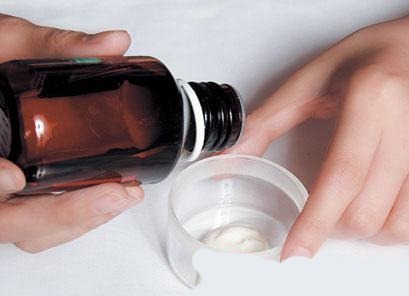Essential oils are usually extracted from plants by a process of steam distillation. This process is difficult to do at home, as it requires specialized equipment, painstaking labour, and huge quantities of plant material. For example, it takes about 200 kg (440 pounds) of fresh lavender flowers to produce 1 kg (2 1/2 pounds) of lavender essential oil. Obviously, most people find that the best course is to buy commercially produced essential oils.
Be careful when shopping for these, however. People buying herbal essential oils for use in the home and in aromatherapy might reasonably believe them to be ‘natural’ – that is, made from the plant written on the label. However, the chemical and perfume industries often adulterate the oil by blending it with synthetics (a method which is allowed by the International Organization for Standardization for essential oils). For example, lemon balm has a low yield on distillation, so commercial lemon balm oil is often mostly synthetic components. To be sure that a herbal essential oil is close to the real thing, you should always buy a reputable aromatherapy brand. Also, it is worth checking that the label carries not just the common name, such as lemon balm, but the Latin species name as well — in this case, Melissa officinalis.
Essential oils are used in a wide variety of ways. To scent a room, they can be added to candles or burned in a special aromatherapy burner. Or, simplest of all, a few drops can be added to a small bowl of hot water, kept warm over a candle (or, if you prefer, on a radiator or a hot plate). Heat increases the rate at which the scented oil vapour is released. These oils can even be added to furniture polish – for many older people, the warm lavender-and-beeswax smell and shine of well-polished furniture brings back childhood memories.
Essential oils can be added to unscented lotions and shampoo, to body and massage oils, or to a bath. When using essential oils in the bath, add five to ten drops after the bath is filled, not while the water is running, so that the oils stay on the water surface. Good oils for bath time relaxation are lavender, marjoram, rose, yarrow, chamomile, and valerian. Some oils, such as eucalyptus, peppermint, rosemary, and basil, are more powerfully aromatic than others, so you may find that you prefer fewer drops of these than of other oils. Alternatively, you can dilute them in a carrier oil before adding to the bath. Try to ensure that there is no draught, or the vaporized essential oil molecules will be blown away instead of forming a scented envelope over the bath. Essential oils can damage the surface of plastic bathtubs, so rinse off fully after use.
Caution
Essential oils are concentrated – use them with care. Do not take essential oils internally. Keep them away from the eyes to prevent irritation. Do not use them undiluted on the skin. Unless otherwise specified, dilute them in carrier oils before use. Keep them away from children. Be careful not to spill undiluted essential oil, as the vapour can be overpowering, especially for young children and pets. Always check that you are not allergic to a particular oil before using it, even in the bath. To test for allergy, add a couple of drops to ‘A cup of water. Blend, then rub a little of the solution on your inner arm. If after half an hour or so there is no reaction, you can use it safely. However, you should still not use to excess or for undue periods of time, or allergic sensitivities and other reactions may develop. Essential oils are flammable and should be stored in a cool, dark place.
Categories
Advertisements
Recent Articles
 How to Understand Bed Sizes – A Small Guide
How to Understand Bed Sizes – A Small Guide How to Select Some Must Have Kitchen Accessories
How to Select Some Must Have Kitchen Accessories Best Way to Change a Car Tire
Best Way to Change a Car Tire Best Way to Write an Affirmation
Best Way to Write an Affirmation Best Way to Take Charge of Your Financial Life
Best Way to Take Charge of Your Financial Life Best Way to Survive a Party When You Don’t Know Anyone
Best Way to Survive a Party When You Don’t Know Anyone Best Way to Stop Self Sabotaging Yourself
Best Way to Stop Self Sabotaging Yourself Best Way to Start Journal Writing
Best Way to Start Journal Writing Best Way to Speak with a Powerful Voice
Best Way to Speak with a Powerful Voice Best Way to Simplify Your Life
Best Way to Simplify Your Life Best Way to Respond to a Put-Down
Best Way to Respond to a Put-Down Best Way to Reduce Acne Breakouts
Best Way to Reduce Acne Breakouts Best Way to Recover from Dining Disasters
Best Way to Recover from Dining Disasters Best Way to Quit Your Job Gracefully
Best Way to Quit Your Job Gracefully Best Way to Make Your Own Website
Best Way to Make Your Own Website


Leave a Reply